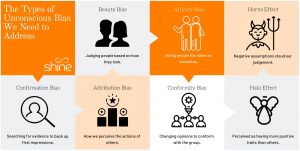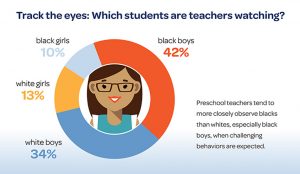It is not a disease. and it can be cured;not with medicine but awareness. it will take a long time to eradicate it if ever, because it took a long time to create and sadly it is part of human nature We see it everyday everywhere. Black lives matter and the protests have brought it to the forefront.
Our lives are based on perceptions not truths. Biases and stereotypes are so ingrained in people’s minds that it is not realistic to think a single training would result in significant reductions in bias. Just as with any change, there first needs to be awareness and an ongoing commitment to the change. This includes workshops, focus groups, dialogues, activities and a solid commitment to change.Step one in awareness; we all have prejudices and stereotypes based on our environment, and experiences.
We operate under assumptions and perceptions. We have always been taught to tell the truth and to look for the truth, BUT…what is truth????
- Our truths are based on perceptions, which are based on our experiences.
- It has been proven that we judge others within the first 30 seconds of meeting.
- It has also been proven that when 2 or more people work or live together, they tend to focus on differences and usually view them negatively.
- When there is no difference, they will invent one and again, view it negatively.
Whenever I do a change management program or anything related to performance I discuss perception. I always start the class asking them to look at me then determine where I am from, describe my hobbies, tell me how I decorated my home, and what is my favorite color.. They usually think I am nuts to ask this. About 1/2 way through the program when we are discussing perception in detail I ask them to answer the questions. Rarely are they right on any of it.
Think about people you have met at networking events or in business; what have you assumed.?
One of the most frequent times of seeing unconscious bias is an interview: jobs, proposals,opening a bank account, and any other occasion in which assumptions play a part
Many well-intentioned individuals are often influenced by their unconscious biases. Our unconscious biases come from direct experiences we’ve had with people, events, and situations as well as through indirect experiences learned through stories, books, media and culture.Because of our biases we may make some inappropriate or even bad selection choices .Research has shown that many hiring decisions are made within the first five to ten minutes of an interview. These decisions are not made on whether or not the person is qualified or capable of performing the job. These decisions are made on first impressions. Referred to as social categorization, we routinely and quickly sort people into groups. The problem with this is that the categories we use to sort people are not necessarily logical, modern or at times legal. Some common biases that may occur in an interview include, stereotyping, the halo/pitchfork effect, nonverbal bias and the “like me” syndrome.
- Stereotyping forming an opinion about how people of a given race, gender, religion or other characteristics will think, act or respond . Women with children will miss a lot of work. A veteran won’t be able to adjust to working in an office. A male candidate will make a better leader than a female candidate.
- Halo/pitchfork occurs when one positive characteristic or strong point made by the candidate influences the entire interview. A candidate has a degree from a prestigious university so you think she must be highly competent and is looked upon favorably. The pitchfork effect is when one negative characteristic or point overshadows the interview. A candidate answers the first two questions of the interview poorly which leads you to believe he is not qualified for the job.
- Nonverbal bias occurs when a positive or negative evaluation is made of someone based on their body language, personal appearance or style of dress. This may include hair length, tattoos, weight, the way someone speaks, mannerisms, or how a candidate is dressed.
- Like me” syndrome also known as Affinity bias occurs when the candidate appears to be very similar to you in style or personality and as a result you feel they would be the best candidate for the job. We have a tendency to favor people who are similar to us. When you are interviewing a candidate with a similar personality, style, interests or experiences you may feel they are the best candidate and base your decision on personal characteristics rather than job related criteria. The “like-me” syndrome can even extend to the same educational background or area of research.
- Attribution bias is a phenomenon where you try to make sense of or judge a person’s behavior based on prior observations and interactions you’ve had with that individual that make up your perception of them.
- Ageism in the workplace is the tendency to have negative feelings about another person based on their age.
- Name bias is the tendency people have to judge and prefer people with certain types of names — typically names that are of Anglo origin. Additionally, applicants living in nicer neighborhoods also receive more callbacks for both white and African American names. Another study found that Asian last names are 28% less likely to receive a callback for an interview compared to Anglo last names.
- Beauty bias is a social behavior where people believe that attractive people are more successful, competent and qualified. While appearances (race aside) are not protected by the Equal Employment Opportunity Commission, it is a form of bias that is prominent in the workplace. One study found that traditionally attractive people, both men and women, earn higher incomes, whereas less attractive people earn lower incomes. Another study found that attractive people are less likely to receive a job offer for roles that are low-paying or perceived to be beneath them. That may be because attractive people are viewed as more social, happy and successful.
-
Height bias or heightism is the tendency to judge a person who is significantly shorter or taller than the socially-accepted human height. This may seem a bit far-fetched, but one study found that a person who is six feet tall earns roughly $5,500 more per year than someone who is five and a half feet tall, regardless of gender, age or weight. Another study found that tall candidates are perceived as more competent, employable and healthy, which may explain why 58% of male CEOs at major companies are over six feet tall. On a personal note. Being 5’2″ not happy about this one
If you have these hidden biases, what can you do about it?
Be aware of your reactions and actions. Take a step back and reflect on how you react to any of theses biases. Where do you get your information? What activities do you do? How do you judge?
- Be aware. The first step in unconscious bias reduction is being aware of what it is and how it can affect others. …
- Question others and yourself. To reduce the effects of unconscious bias, question biases in yourself and raise awareness in others. …
- Create inclusive meeting practices. …
- Create a supportive dialogue. …
- Take action.
It starts young

Aspire to make a difference.
Very important and up to date subject. This post explained and clarified what biases are and how to deal with them very well. Thank you for sharing.
The key is recognizing that they are unconscious and being aware you have them. We can only change when we are aware.